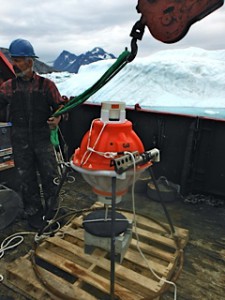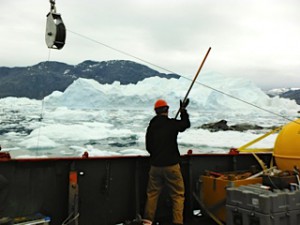Throwing moorings into the ocean and expecting to get them back comes with risk. And if you’re the worrying type, strapping expensive equipment to a massive anchor and dropping it over the side of a vessel might not be for you. You’ll have months of stress as you anxiously sit at your desk analyzing some other data sets, wondering: Are your instruments making any decent measurements? Will the ship and mooring be able to communicate once it’s time for recovery? Will the mooring even be where you left it?
And if you’re deploying in an ice-filled fjord you can add to that worry-list. Will the site be ice-covered when it’s recovery time? Is the mooring’s shallowest float well below the iceberg keels, or is your mooring getting smacked by an especially deep berg? That happens. And when it does, someone like Willi Ostrom, one of our mooring gurus here at the Woods Hole Oceanographic Institution, goes through heroic efforts to drag for the instrument (hard enough in the open-ocean, and incredibly challenging in a fjord where you and the ice are jockeying for the same space). That’s when everyone on the ship gets put to work…fending the ice off the lines.
It must have been after a really hard field season when Fiamma Straneo said to me, “What do you think about putting a PIES in the fjord?” Really? I had only used PIES (pressure-sensor-equipped inverted-echo-sounders) in transport studies of western boundary currents (think geostrophy and no ice). But Fiamma was looking for a way to determine the time-varying heat content in a fjord. Individual hydrocasts or XBTs (which provide measures of the water’s temperature and salinity as a function of depth) are good, and necessary, but only give us snapshots of water properties in the fjord. A PIES, on the other hand, can measure the echo-time very accurately every hour for long periods. (This echo-time is the time it takes a set of 12 kHz acoustic “pings” generated by the PIES to travel from the instrument on the seafloor to the sea surface – where they get reflected – and back again where the detector on the PIES is listening for the echoes.) By using historical hydrography for context, the echo-time is an excellent proxy for vertically-integrated heat content because the speed of sound in seawater is strongly constrained by the water’s temperature (sound travels faster in warmer water than in colder water). A PIES also measures bottom pressure and serves as a perfect stand for a Microcat which can make continuous measures of bottom temperature and salinity. In addition, PIES can be deployed and recovered from small boats and can stay put for up to 5 years (the battery limit). And a PIES sits in its rigid mount on the sea floor (in 500 m – 6000 m water depths), out of the reach of iceberg keels.
While PIES have been widely used in the open-ocean, no one had been putting them in a fjord…until recently. In August 2013, we (Fiamma, Willi, Nick Beaird, Rebecca Jackson and myself) deployed 3 PIES from the Viking Madsalex sited at the mouth of Sermilik Fjord, mid-fjord and as close to Helmheim glacier as we could get. This follows on the heels of a 1-year pilot study (2011-2012) in which Fiamma and Dave Sutherland deployed and recovered a borrowed PIES (many thanks to Randy Watts, Erran Sousa and the rest of the PIES group at the University of Rhode Island!) during their previously planned field work.

A PIES deployment in Sermilik in August 2013 with an on-the-fly modification: a pallet strapped to the bottom of the anchor stand to prevent the instrument from sinking into the oozy bottom. At sea we’re usually prepared to “McGyver” things together (albeit in this case without duct tape). There is also a Microcat strapped to the PIES housing to measure temperature and salinity at the bottom.
2011-2012 was a great year for the PIES pilot study because there are contemporaneous measurements in the fjord from nearby sites. We are busy analyzing these data, validating our PIES methods and trying to understand dynamics within the fjord. Meanwhile, our 3 PIES are collecting two more years of measurements in Sermilik getting us closer to understanding Greenland’s interannual variability.
And sure, I’m worrying about the 3 PIES a little. Are they still pinging? Will we be able to get the deckbox and PIES to communicate at recovery? But I’m not worrying about icebergs. Bring them on, our instruments are deep, safe from those keels and tracking them as they go by.

